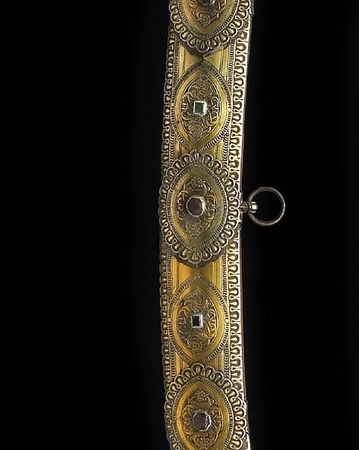History Written With A Sword Early Gem-Set Saber To Highlight June Arms & Armor Auction
At its Antique Arms & Armor sale on June 20, 2011 in San Francisco, Bonhams & Butterfields is excited to present a historic gem-set saber, likely 17th century Turkish and originating from Mysore, India during the period of the Tipu Sultan's ruling (est. $15,000-25,000).
The gilt silver-mounted sword boasts an impressive, curved 32½-inch long blade and is adorned with a crossguard chased in floral engravings. As well, the grip on the wide saber is covered with engraved, gilt-silver plates.
The historic saber is accompanied by a gilt-silver plate covered scabbard, which boasts elaborate scrollwork and borders. The front is set with thirteen precious and semi-precious stones and the reverse is covered in dark shagreen and inscribed with the words: "Taken from/Tippoo Saib (sic)/Seringapatam/1799."
The sword's origin points to a robust period in India's history – the 1780's - during which the Tipu Sultan ruled India's strongest, most prosperous state. Tipu was a relentless warrior who inflicted defeats on the British and used Western weaponry against their inventors. He was killed at the siege of Seringapatam in 1799.
Tipu Sultan or Tipu Sahib was born in Devanhalli on 20th November 1750 to Haider 'Ali (1721-82) and his second wife Fatima, or Fakr-un-Nissa. Haider 'Ali was a soldier, who had risen through the ranks of the Mysore army to the point where he was able to establish himself as de facto ruler, usurping the brothers Nanjaraj and Devraj in 1752. In 1782 Tipu succeeded his father as Sultan of Mysore, which was the strongest, the best governed and the most prosperous state in India. He was killed at the siege of Seringapatam in 1799. His famous throne was broken up as loot and a number of swords and other objects were taken by members of the victorious British forces. For an article of some of these weapons see, Robin Wigington, Souvenir Weaponry From Seringapatam, The Journal of The Arms & Armour Society, Vol.XV, No.3 (March, 1996), pp.141-149.

/https%3A%2F%2Fprofilepics.canalblog.com%2Fprofilepics%2F1%2F0%2F100183.jpg)
/https%3A%2F%2Fstorage.canalblog.com%2F03%2F02%2F119589%2F96711876_o.jpg)
/https%3A%2F%2Fstorage.canalblog.com%2F11%2F31%2F119589%2F94773502_o.jpg)
/https%3A%2F%2Fstorage.canalblog.com%2F20%2F83%2F119589%2F94772815_o.jpg)
/https%3A%2F%2Fstorage.canalblog.com%2F26%2F72%2F119589%2F75604929_o.jpg)
/https%3A%2F%2Fstorage.canalblog.com%2F59%2F60%2F119589%2F26458628_o.jpg)






/http%3A%2F%2Fstorage.canalblog.com%2F32%2F99%2F119589%2F129836631_o.jpg)
/http%3A%2F%2Fstorage.canalblog.com%2F46%2F82%2F119589%2F129704536_o.jpg)
/http%3A%2F%2Fstorage.canalblog.com%2F49%2F48%2F119589%2F129680938_o.jpg)
/http%3A%2F%2Fstorage.canalblog.com%2F64%2F83%2F119589%2F129635530_o.jpg)